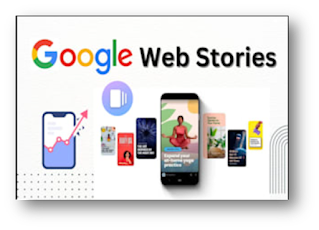Tap into Google's Spotlight: Unleashing the Power of Web Stories for Marketing
In my article "Google WebStory: A New Way to Connect with People" I explain what Google WebStory is and how it is a new method to present content.
Now, in this essay, I'll go over how it may be used as a marketing tool.
Here are some ways you can use Google Web Stories as a marketing tool:
- Tell your brand story: Stories are a great way to tell your brand story and connect with your audience on a deeper level. You can use stories to share your company's history, mission, and values.
- Highlight your products and services: Stories are a great way to highlight your products and services in a visually appealing way. You can use stories to showcase your products in action, or to provide educational content about your services.
- Drive traffic to your website: Stories can be a great way to drive traffic to your website. When you publish a story, you can include a link to your website in the story description. This will make it easy for users to click through to your website and learn more about your business.
- Generate leads: Stories can also be used to generate leads. When you publish a story, you can include a call to action in the story description. This could be a link to a landing page where users can sign up for your email list, or a link to a contact form where users can inquire about your products or services.
Google Web Stories is a terrific option if you're seeking for a fresh way to sell your company. They are simple to develop, entertaining, and can assist you in reaching a larger audience. Find out more about making web stories. click here to read the blog article "Best tool for creating web stories"
Here are a few more hints for using Google Web Stories as a marketing tool:
- Use high-quality images and videos: Stories are a visual medium, so it's important to use high-quality images and videos. This will help your stories stand out and capture attention.
- Keep your stories short and sweet: Stories are meant to be quick and easy to consume. Aim for stories that are no more than a few minutes long.
- Use a consistent style: Your stories should have a consistent style, from the images and videos you use to the fonts and colors you choose. This will help your stories look professional and polished.
- Promote your stories: Once you've created your stories, be sure to promote them on social media and your website. You can also use Google Ads to promote your stories to a wider audience.
- Brand Awareness: Use Web Stories to create visually appealing and engaging content that showcases your brand's story, products, or services. By presenting your brand in a captivating format, you can increase brand awareness and leave a lasting impression on your audience.
- Product or Service Highlights: Highlight specific products or services through Web Stories. You can create interactive and informative stories that showcase the features, benefits, and unique selling points of your offerings. This can help generate interest, drive traffic, and potentially increase conversions.
- Promotions and Offers: Use Web Stories to promote special deals, discounts, or limited-time offers. The visual and interactive nature of Web Stories can help capture attention and encourage users to take action, such as making a purchase or signing up for a newsletter.
- Storytelling and Engaging Content: Web Stories provide an opportunity to tell engaging and immersive stories related to your brand or industry. You can use storytelling techniques to create narratives that resonate with your audience, evoke emotions, and build a connection with your brand.
- Content Distribution and Traffic Generation: Sharing your Web Stories on social media platforms, embedding them on your website, and promoting them through various channels can help drive traffic to your website. Web Stories can serve as a gateway to your other content, leading users to explore more of your offerings.
- Audience Engagement and Interaction: Utilize interactive features within Web Stories to engage with your audience. Incorporate polls, quizzes, or interactive elements that encourage users to participate and interact with your content. This can help increase engagement, gather valuable insights, and foster a sense of community.
- SEO Benefits: Web Stories have the potential to rank in search engine results, providing an additional opportunity for organic visibility. By optimizing your Web Stories with relevant keywords, descriptive titles, and engaging content, you can enhance their chances of appearing in search results and driving organic traffic.
Remember to align your Web Stories with your overall marketing strategy and goals. Plan your content, consider your target audience, and track the performance of your Web Stories using analytics tools to measure their impact on your marketing efforts.




